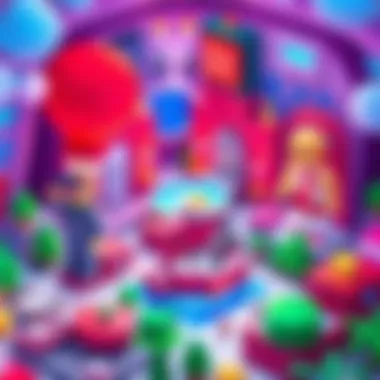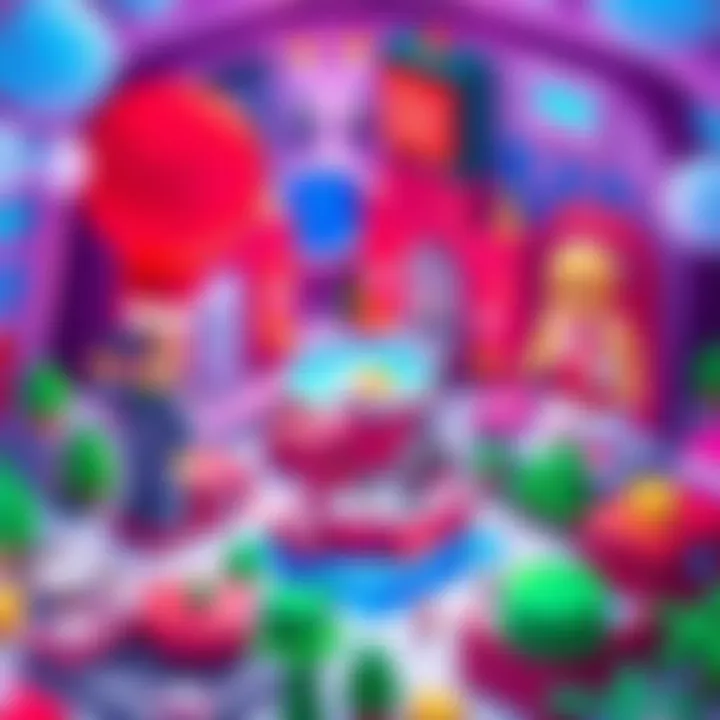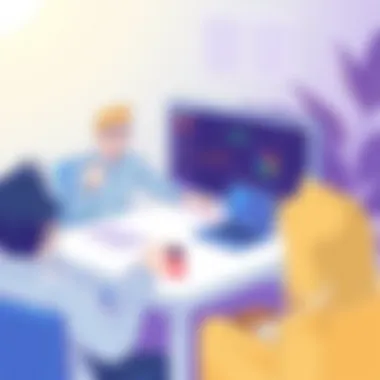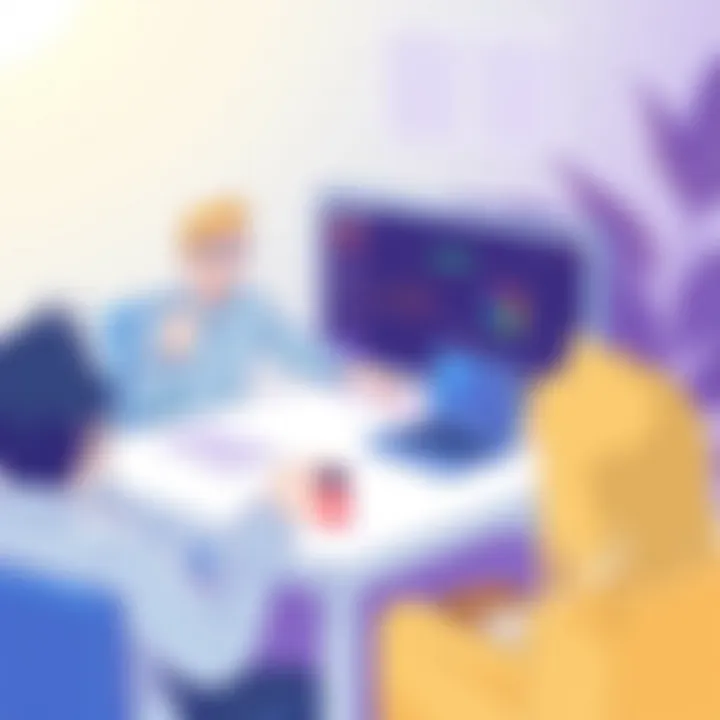Mastering Roblox Game Development: A Step-by-Step Guide


Intro
Creating a game on Roblox isn't just a matter of writing code and placing blocks; it’s about weaving together creativity, technical skills, and an understanding of your audience. In a landscape filled with user-generated experiences, the task can seem daunting. However, the world of Roblox provides not just the tools but also a vibrant community and resources that can help you every step of the way.
This guide aims to illuminate the path for both newcomers and seasoned developers alike. We’ll cover vital concepts, tools, and strategies that contribute to the successful launch of a Roblox game. From familiarizing yourself with the platform to navigating post-launch challenges, we’ve got you covered.
Let’s explore the key areas that this guide will delve into:
- Understanding Roblox Studio: A dive into the development environment.
- Game Design Fundamentals: Tips on creating an engaging experience.
- Scripting Basics: Getting to grips with Lua programming.
- Community Engagement: How to attract and maintain an audience.
- Monetization Strategies: Exploring how to profit from your game.
- Post-Launch Maintenance: Keeping the game fresh and exciting.
Product Overview
Roblox Studio is the heart of game creation in the Roblox ecosystem. This platform is packed with features, enabling developers to create everything from simple obstacle courses to complex machinery simulations. Here’s a breakdown of what makes Roblox Studio such an essential tool:
- Drag-and-Drop Interface: Great for beginners; you can quickly place objects in your game with minimal coding.
- Script Editor: For the more advanced, this aspect lets you write Lua scripts to bring your game to life.
- Asset Marketplace: Access to a wealth of user-generated assets, sounds, and scripts. Avoid re-creating wheels when you can leverage existing resources.
- Collaboration Tools: Work with other developers, share ideas, and build multiplayer experiences seamlessly.
Roblox also boasts a diverse community, providing forums and channels where newcomers can ask questions and share their work. This connectivity serves to enhance the overall learning experience.
Performance and User Experience
When it comes to performance, Roblox games can vary widely. Typically, well-crafted games run smoothly on a range of devices. Key points to consider include:
- Optimization: It's paramount. Make sure to regularly test your game to catch performance dips. Too many parts or complex scripts can lead to lag.
- User Interface: A clean layout makes a massive difference. Ill-defined buttons or cluttered screens can overshadow even the best gameplay mechanics.
- User Feedback: Keep an ear to the ground. Players can provide invaluable insights into what works and what falls short in your game.
"Creating something enjoyable requires listening more than talking; let your players guide you!"
Design and Build Quality
Design in Roblox is oftentimes seen as the skeleton of your game. Visual appeal can hook players. Think about:
- Visual Style: Is your game bright and welcoming or does it have a darker, more gritty palette?
- Theming: A consistent theme can unify your game and deepen immersion.
- Quality Assets: Don't skimp on the details. Invest time in refining models and textures for a polished feel.
Technology and Innovation
While Roblox itself may not be groundbreaking in a technological sense, the creativity of its users shines through. Here’s how:
- Scripting Innovations: Developers often create unique gameplay mechanics through clever scripting.
- Augmented and Virtual Reality: There’s potential for using AR technology within Roblox; keep an eye on future updates.
- Game Genres: Observe trends. Are tycoon games making a comeback? This information can fuel your game development ideas.
Pricing and Value Proposition
When it comes to the economics of game development in Roblox, keep in mind:
- Game Monetization: Implementing in-game purchases can turn your project into a revenue-generating venture.
- Affordability: Most resources to get started are free or low-cost, making it accessible for a wide audience.
- Value Compared to Competitors: Unlike many gaming platforms, Roblox offers a unique opportunity for independent creators.


Understanding Roblox as a Game Development Platform
In the ever-evolving landscape of digital gaming, Roblox stands out as a vibrant canvas for creators who wish to blend imagination with technology. Understanding Roblox as a game development platform is crucial for any aspiring developer looking to carve their niche in the gaming universe. We’ll unpack the significance of this platform, its unique offerings, and how it empowers users to bring their creative visions to life.
Overview of Roblox
Roblox isn’t just a game; it’s an entire ecosystem where millions gather to play, create, and share their own experiences. It allows anyone, regardless of age or background, to develop games using its accessible tools. Unlike traditional game development, which often requires extensive knowledge of complex programming, Roblox simplifies the process through its user-friendly interface.
Moreover, its appeal lies in its wide array of genres, from thrilling adventures to intricate simulations, giving developers the freedom to experiment and explore different gameplay styles. This variety attracts a diverse player base, providing unbounded opportunities for new game designers to reach potential fans who are eager for fresh content.
Key Features of Roblox Studio
Roblox Studio is the jewel in the crown of Roblox. This powerful development tool allows creators to design, build, and publish games with relative ease. Here are some standout features that make it indispensable for developers:
- Intuitive Interface: The layout is designed for ease of use, allowing both newcomers and seasoned developers to navigate the platform effortlessly.
- Roblox Lua Scripting: This lightweight, easy-to-learn scripting language enables detailed game mechanics, allowing developers to introduce complex logic and interactivity.
- Asset Management: Developers have access to a vast library of assets like models, sounds, and animations, making it easier to create engaging environments without starting from scratch.
- Multi-Platform Support: Games made on Roblox can be played on PCs, tablets, and mobile devices, expanding reach and engagement opportunities.
- Collaboration Tools: The platform supports team projects, allowing multiple developers to work together seamlessly.
The Roblox Ecosystem
Understanding the broader Roblox ecosystem is key to successfully navigating the development landscape. Beyond simple game creation, Roblox fosters a community where players can socialize, collaborate, and share achievements. The social interaction element is pivotal; developers can draw inspiration from player feedback and trends within the community.
Furthermore, the economy of Roblox is unique, allowing users to earn real money through in-game purchases and game passes. This creates a motivating factor for developers to invest time and creativity into their projects.
- Community Engagement: Being part of this environment means developers must actively engage with players to build loyal fanbases.
- Event Participation: Roblox frequently hosts events and challenges, creating opportunities for developers to showcase their work and gain visibility.
- Marketplace: Within the ecosystem, a marketplace exists where asset creation and trading offer additional avenues for income and creativity.
Ultimately, recognition of these fundamental aspects of Roblox as a game development platform empowers developers to leverage their tools effectively, ensuring they create games that resonate with audiences and thrive in a competitive market.
"Roblox is not just a platform; it's a community-driven playground where creativity knows no bounds!"
Arming oneself with this knowledge sets a solid foundation for embarking on the exciting journey of game development in Roblox.
Setting Up Your Roblox Game Development Environment
Setting up your Roblox game development environment is like laying the foundation for a house; without a strong base, the entire structure might crumble. This stage is critical, as it ensures you have the right tools at your disposal and that you understand the interface of Roblox Studio, the primary tool for game development in Roblox. Getting this part right can save you countless hours of frustration down the line.
Creating a Roblox Account
The first step in this journey is to create a Roblox account. It all begins here. To get started:
- Visit the Roblox website at roblox.com.
- Click on the 'Sign Up' button prominently displayed on the homepage.
- Fill out your details—username, password, and birthday. Choose wisely; your username represents you in the game world.
- Accept the terms and conditions. This part's crucial because you want to know what you're getting into.
Once your account is created, make sure to verify your email. This adds a layer of security and ensures you can recover your account if needed. It might sound trivial, but it’s a wise move. A forgotten password can lead to unnecessary headaches.
Installing Roblox Studio
With your account set up, the next step is to install Roblox Studio. This is where the magic happens—where you will build, test, and ultimately publish your game. Here’s how:


- Log into your Roblox account.
- Navigate to the Create page. You will find this option in the menu.
- Look for the 'Start Creating' or 'Create New' button, and click it. This action triggers a download for Roblox Studio.
- Once downloaded, run the installer and follow the prompts to complete the installation.
Having Roblox Studio on your machine means you’re one step closer to bringing your imaginative ideas to life. The installation process is straightforward, designed for ease and accessibility.
Navigating Roblox Studio Interface
You’re in! Now, it’s time to familiarize yourself with the Roblox Studio interface. Think of it as stepping into the cockpit of an aircraft; knowing the controls is essential for smooth flying. Here are some key elements of the interface you should pay attention to:
- Explorer: This panel shows all the objects in your current game. It’s like the blueprint of your project.
- Properties: Clicking on an object in the Explorer lets you see its properties here. Want to change the color of a block? This is where it happens.
- Toolbox: A treasure trove filled with models, scripts, and other assets that can be dragged directly into your game.
- Viewports: This is your game world, where the action unfolds. This is where you’ll spend most of your time designing and testing.
Tip: Take some time to explore each panel. Familiarity with the interface will enhance your efficiency, allowing you to focus more on creativity and less on navigation mishaps.
Conceptualizing Your Game Idea
In the realm of game development, laying a solid foundation is essential for future success. The phase of conceptualizing your game idea is not just a preliminary stage; it’s the cornerstone that can dictate the trajectory of your project. A well-defined concept can guide your design choices, engage your players, and enhance their experience. So, it's crucial to get this right from the get-go. In this section, we will explore the vital components that come into play while brainstorming your next big Roblox venture.
Identifying Your Target Audience
When creating a game, knowing who you are making it for really sets the stage. The concept of a target audience embodies understanding the preferences, interests, and habits of your potential players. Without this insight, you might be floundering in the dark, crafting a game that might not resonate with anyone.
To start identifying your audience, consider the following:
- Age Group: Younger players may favor colorful graphics and simple mechanics, whereas older players might seek complexity and rich storytelling.
- Interests and Trends: Research popular games within Roblox to gauge trends. What are players currently enjoying? Is it adventure, simulation, or role-playing games?
- Gameplay Habits: Do players prefer solo experiences, or do they thrive in multiplayer settings? Understanding their social interaction style can help you mold your game.
One effective way to gather this data could be through community forums on platforms like Reddit or the Roblox Developer Forum. Engaging with players directly can provide valuable insights and foster a sense of connection well before your game’s launch.
Defining Game Mechanics
Next up, let's discuss game mechanics. These are the rules and systems that guide player interactions within the game. Think of them as the blueprint of your game design. A strong understanding of mechanics not only enriches player experience but can also make or break the gameplay.
When defining your mechanics, consider the following elements:
- Core Mechanics: What is the main action players will perform? Jumping, sprinting, building? This can vary greatly based on the game genre.
- Progression Systems: Will you implement leveling up? How will players achieve goals?
- Challenges and Rewards: Balance is key here. Make sure to provide enough challenge to keep players invested without making it frustrating.
- Feedback Systems: Consider how players receive feedback in-game, whether through sound effects, visual cues, or notifications. This can amplify the gaming experience significantly.
The creation of mechanics may draw inspiration from successful games, yet the crux is to ensure they complement your unique vision. A good way to visualize these concepts is to sketch flowcharts that map out player actions and expected outcomes.
Creating a Game Design Document
Having a game design document (GDD) is akin to having a roadmap for your journey. It succinctly articulates your overarching vision, and serves as a guiding framework during the development process. This document should encompass a variety of sections, such as character bios, environment descriptions, and gameplay mechanics.
Here’s what to include in your GDD:
- Game Overview: Briefly describe your game, its themes, and what makes it stand out.
- Visual Styles: Include references to inspire the aesthetic. Are you mimicking the look of classic 8-bit games, or are you going for a gritty, realistic design?
- Storyline: Lay out a brief narrative arc. What motivates the player? Are there quests or missions?
- Technical Aspects: Detail the technologies you plan to utilize within Roblox Studio.
- Development Timeline: Establish your milestones and deadlines to keep your project on track.


By pouring your ideas into a GDD, you create clarity and purpose, making collaboration with team members—or even future updates—much smoother.
Key Takeaway: The process of conceptualizing your game idea goes beyond just creativity; it requires a strategic approach and knowledge of your audience. Properly executed, you can deliver an immersive experience that resonates well with players, retaining their loyalty in the long haul.
In summary, the phases of identifying your target audience, defining game mechanics, and creating a game design document work collectively to ensure that your game idea is solid and ready for development.
Developing Your Game World
Creating a rich and immersive game world is at the very heart of a successful Roblox game. A well-designed environment not only serves as the backdrop of your narrative but also elevates the whole gameplay experience. When players enter your game, the world they explore should feel alive and engaging. Now, let’s delve into some critical aspects of developing your game world.
Designing Environments Using Roblox Studio
The beauty of Roblox Studio lies in its intuitive design tools that empower developers to bring their visions to life. Crafting environments involves more than just placing blocks and assets; it’s about storytelling through visuals. Every inch of your game’s landscape can convey themes and emotions, creating a sense of place.
- Understanding Terrain Tools: Roblox Studio provides terrain manipulation tools that let you sculpt landscapes. You can adjust size, shape, and texture to create everything from rolling hills to deep valleys. Mastery of these tools allows for a more naturalistic look to your environments.
- Using Color and Texture: Beyond shapes, color and texture play a pivotal role in atmosphere. Consider how colors evoke feelings—warm tones can bring warmth, while cooler shades may establish a moody tone. Texturing is another layer; it adds depth and realism. Explore surfaces like grass, concrete, or even stone to enrich the player's exploration.
Incorporating Models and Assets
In a world where every detail counts, incorporating models and assets is fundamental. The right models can enhance the gameplay, providing players with interactive experiences. You might use pre-made models from the Roblox library or create custom assets to suit your unique style.
- Creating Custom Models: Custom models give your game a distinct flair. With tools available in Roblox Studio, you can construct any object from vehicles to furniture—a simple block can turn into a treasure chest with some creativity.
- Leveraging Existing Resources: Apart from creating, don’t overlook the vast library of user-generated content available. Websites like Reddit and the Roblox Developer Forum can be fantastic resources for inspiration and guidance. Just make sure to respect the creators’ rights when utilizing their work.
Lighting and Atmosphere
The atmosphere can make or break the immersion in your game. Lighting is more than just an aesthetic choice; it shapes player perception. The use of shadows and brightness can guide players through your game, set moods, and provide a sense of realism.
- Dynamic Lighting: Utilizing dynamic lighting can bring energy to your scenes. Day-night cycles or changing weather can alter the feel of your world substantially—turning a sweet village into a haunted place when the sun is down.
- Special Effects: Add fog, particle effects, and even sound to enhance the experience. For instance, a misty swamp can feel eerie with the right soundscape. Consider these details to enrich how players experience your game at every corner.
Remember: The goal of developing your game world is not just to fill space, but to create a vibrant universe where players can lose themselves in minute interactions, environment storytelling, and compelling visuals.
In summary, developing your game world in Roblox is an intricate and vital process. By thoughtfully designing environments, incorporating unique models and optimizing lighting, you will captivate audiences and provide them a tangible reason to keep coming back to your game.
Implementing Game Mechanics
Developing engaging game mechanics is a cornerstone of any successful Roblox title. These mechanics dictate how players interact with the game and what they can achieve, shaping the overall user experience. A well-thought-out game mechanic keeps players interested and encourages them to return. It's the difference between a lackluster gameplay experience and one that gets players buzzing with excitement.
When creating a Roblox game, pay close attention to how mechanics can enhance your vision. From movement to combat, resource gathering, or puzzle-solving, each aspect must align with the game’s goals and narrative. Additionally, it’s crucial to consider the balance and pacing of these mechanics, as good game design will lead to an addictive experience, keeping players engaged for hours on end.
Using Lua Scripting for Game Logic
Lua scripting is a powerful tool within Roblox that allows developers to define their game’s logic and mechanics. With Lua, you can control nearly every aspect of your game, from player interactions to world dynamics. It’s flexible and relatively easy to learn, making it an excellent entry point for coding novices.
Here are some essential areas where Lua scripting shines:
- Event Handling: You can set up events that respond to player actions, such as clicking a button or touching an object. This responsiveness leads to a more interactive experience.
- Game State Management: Track the state of your game, whether it’s keeping score or managing the level progression. This is vital for creating an engaging narrative or scoring system.
- Object Manipulation: With Lua, you can dynamically create and modify game objects. For instance, spawning unique NPCs (non-player characters) or adding power-ups on the fly enhances gameplay and player immersion.
A simple Lua script to manage player health could look like this: lua local playerHealth = 100
function takeDamage(amount) playerHealth = playerHealth - amount print("Player Health is now: " .. playerHealth) end



